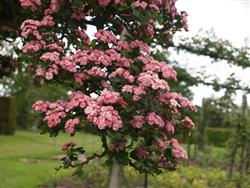Cretagus -Hawthorn

Cretagus are a large genus of around 100 species, commonly known as Hawthorns, and from the Northern hemisphere.
They are mainly deciduous, thorny shrubs to small trees with small, alternate, simple, toothed or lobed leaves, that may colour attractively in autumn. Flowers in corymbs, and mainly white to reddish, and mainly flowering in spring to early summer. The flowers are usually followed in autumn to winter by attractive small fruit (pomes) which are commonly red, yellowish or orange in colour.
Worth growing only in cool temperate climates. Generally most are quite hardy, doing best in fertile, moist but well drained soils in cooler areas. Protect from hot, dry winds. Most will tolerate medium to heavy frosts. Once established plants rarely much attention. Feeding, watering or pruning established plants is not a routine necessity. Fertilising may help vigour and berry production, but is not normally something to worry about. Pruning is used to hedge many species, or to thin out rubbing branches, or to train them as single-trunk trees. Most species are easily propagated from seed that has been removed from the fruit and stratified over winter, then sown in early spring. Germination can be very slow and irregular. Cultivars and hybrids should be budded or grafted onto seedling rootstocks.
Slugs attack fruit or foliage, and may need to be controlled. A wide range of other insects may occur on Crataegus (including Aphids, borers, leaf miners, scale, mites, leaf hoppers etc); but they are unlikely to be too serious. A wide range of fungal problems might also occur (Blight, Rust, Leaf spot, Scab, Powdery Mildew); but again they are unlikely to be too serious.
Cultivars
C. crus-galli – A large shrub to small tree to 6m tall, with a broad conical crown to 5m wide.
Narrow elliptic-ovate to oblong leaves with rounded and fine-toothed at the tip, to 8cm long. Flowers to 1.5cm across in corymbs, flowering in September to October. Fruit are bright red to crimson pomes (berry-like) with brown spots to 13mm diameter occurring in late summer to mid-winter.
C. durobrivensis - Large white blooms (25mm). Grows up to 4.5m tall.
C. x grignonensis - Wavy-toothed leaflets and red globe-shaped fruit.
C. laevigata – Up to 8m tall thorny tree with 15mm wide flowers and deep red fruit.
C. x lavallei - Dark green leaves on a 7m tall thorny tree. 20mm wide flowers followed by orange-red fruit.
C. monogyna - A tall tree up to 10 m, but usually less, flowers up to 15mm wide, bright red fruit.
C. pinnatifida var. Major - Dark green 5-9 lobed leaves, on a partially thorny tree to 7m. 15mm wide flowers and light red dotted fruit.
C. pubescens (syn. C. mexicana) – 4-6m tall with no thorns, coarsely toothed foliage and 20mm wide white flowers with rounded, golden-yellow spotted fruit.
C. x smithiana – A small thornless tree to 6m with large red berries and striking autumn foliage.
C. stipulaceae -Bluish green foliage, yellow fruits to around 5m tall.
Learn More about Plants through an ACS Plant Variety course.
Click for details: http://www.hortcourses.com/courses/product_listings.aspx?catid=Plant+Varieties
For Australian Native Plants, Click here http://www.hortcourses.com/courses/product_listings.aspx?catid=Australian+Native+Plants
You may also be interested in....
Exceptional training for a serious business or career -lots of different options to specialize.
View Course